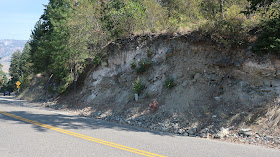The geology of the Similkameen valley shaped the early US government policies in Washington State.
View of the Similkameen River and eastern North Cascades
The Similkameen River drains the east slopes of the North Cascades and flows out of British Columbia into Washington State within a very deep glacial carved valley. The rise in elevation from the floor of the valley to the summit ridge on the west side of the valley at Chopaka Mountain is 6,500 feet.
The valley and the mountains around it were briefly part of the short lived Columbia Indian Reservation. Chief Moses traveled to Washington DC in 1879 seeking recognition for his band of Columbia Indians; he and had not signed previous treaties in the 1850s and also refuse to go to the Yakama or Colville Reservations. His initial preference was to have a reservation that encompassed the northwest half of the Columbia Basin. But during his trip to Washington DC a reservation was agreed to that was approximately bound on the east by the Okanogan and Columbia Rivers, on the south by Lake Chelan, on the west by line of longitude that nearly reached the Skagit River and on the north by the Canadian border. President Hayes issued executive orders in 1879 and 1880 that stated that reservation was "withdrawn from sale and settlement and set apart for permanent use and occupation of Chief Moses and his people."
However, the new reservation already had mining claims. In particular, the Smilkameen valley was already an established mining district with several mining claims in the valley. Political pressures were applied by mining interests.
Mine tailings and old mill at the base of Chopka Mountain
Another executive order was issued in 1883 removing the northern 15 miles of the Columbia Reservation. More mining interests as well as ranching continued to create conflict. In addition, Moses and his band did not move onto the new reservation. Yet another executive order was issued in 1886 erasing the reservation completely. During the negotiation, Moses accepted a yearly stipend and then moved to the Coleville Reservation.
Similkameen valley south of the Canadian border
Some mining did take place in the Similkameen post reservation era. Placer mining still takes place within the river itself, but the mines never amounted to much. A rail line from Canada was built in the valley by the early 1900s. But the valley is now has very few residences. Much of the valley floor regularly floods. A few hay operations are still present. And Indians are shaping the future of this valley. The Colville Confederated Tribes have purchased several large tracts of land.














